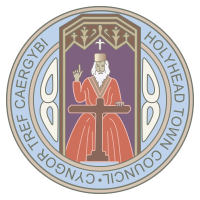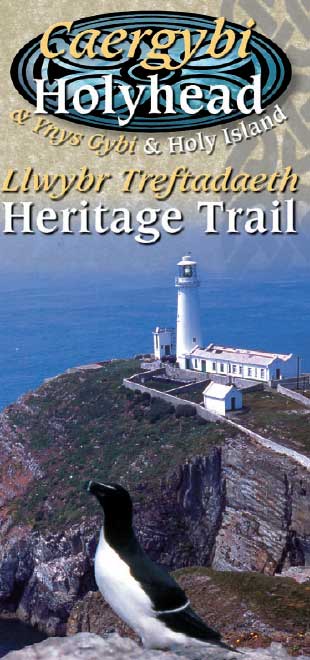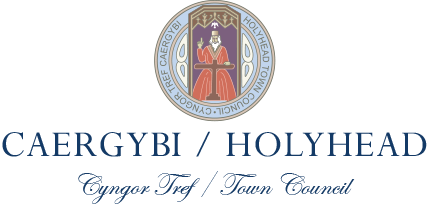Welcome to Holy Island – a part of Anglesey steeped in centuries of human history and rich in wildlife and natural beauty. A place of wild heather-clad hill tops, towering sea cliffs, rare sea bird colonies, unspoilt green countryside and ancient buildings and monuments.
Take time to explore Holyhead's heritage and you will discover a long and fascinating history filled with stories of fortune and tragedy; of saints, soldiers and smugglers; of courageous sea rescues and of literary legends and ingenious engineers. So why not exercise your legs and your imagination as you explore this bustling port town?
Download a copy
Take a walk on the wild side
A great way to explore Holy Island is on foot and by using public transport. Within a few minutes you could be walking the Isle of Anglesey Coastal Path, enjoying stunning panoramic views, visiting ancient monuments and witnessing the colourful and noisy drama of sea bird colonies.
For more information on the coastal path call 01248 752495, or visit www.angleseycoastalpath.com
The Heritage Trail
1. Holyhead Mountain
Although it only stands at 220 metres (720 ft), Holyhead Mountain is Anglesey's highest point. From its heather-clad summit there are spectacular views of Holyhead and towards Snowdonia, the Llyn Peninsula and the Great Orme. On a clear day you can also see the Isle of Man and Ireland.
2. Breakwater Country Park
This former quarry (created during the construction of Holyhead's Breakwater) is now a wildlife haven and a great place to begin exploring Holyhead Mountain and Rocky Coast. There is a small information centre and shop too. Tel: 01407 760530
3. Trefignath Burial Chamber
A series of three chambers used over a period of 1,500 years. The earliest may have been raised around 3750 BC on the site of a Neolithic (New Stone Age) settlement
4. Hill fort
There is a huge Iron Age hill fort at the summit of Holyhead Mountain, within which stands the ruin of a fourth century Roman watchtower.
5. Tŷ Mawr Hut Circles
Tŷ Mawr Hut Circles Lying amongst bracken and heather are the remains of a settlement dating back to the Neolithic period (late Stone Age). Several interesting archaeological finds have been unearthed here, including hammers, whetstones, coins and pottery. People lived here more or less continuously between 200 BC and 500 AD.
6. South Stack
Whether it's the dramatic setting of the 19th century lighthouse and suspension bridge at the foot of 60 metre (200 ft) cliffs or the fragrance and colour of the coastal heath and spectacle of thousands of nesting sea birds perched perilously on cliff ledges – you are bound to find something to delight when you visit. Guided walks organised by the Royal Society for the Protection of Birds (RSPB) set off from the nature reserve visitor centre at Elin's Tower throughout the summer. For details contact: 01407 764973.
7. Coastal Park
The sheltered flats of Beddmanarch Bay attract wildfowl, seabirds and waders. Enjoy a picnic in woodland glades nearby and a stroll around one of the clearly marked nature trails. Tel: 01407 763333. You can also visit the Toll House Café. Tel: 01407 760247.
8. Penrhosfeilw
According to local tradition these impressive 3m (10ft) tall Bronze Age standing stones were once at the centre of a stone circle.
1. Station Clock
The station clock commemorates the opening of the new station in 1880 by the then Prince of Wales, Albert Edward.
2. Eagle and Child
The Eagle and Child, later the Royal Hotel, marked the end of the journey for the 18th century Mail and Stage coaches arriving from London. You can still see the large door through which the carriages once passed into the yard behind.
3. Market Square
Up until the 1860s this square was the commercial heart of the town. Traders came from all over Anglesey to sell their wares on the Market Cross steps. This was the traditional public gathering place during fairs and festivals. The street market was re-established in 2002 and is held every Monday.
4. Stanley House
Built in 1810 by the Stanley family, this house was the residence of Captain John McGregor Skinner, one of Holyhead’s most illustrious residents and famous seaman, drowned in a storm near South Stack in 1832. His pet raven often accompanied him, travelling on his shoulder!
5. Skinner’s Monument
The obelisk overlooking the harbour commemorates Captain John McGregor Skinner.
6. St Cybi’s Church
The original 6th century church was made of wood. The oldest elements of the existing parish church date from the 13th century. The walls enclosing the church yard are the remains of a 4th century Roman fort considered to be the oldest and most complete remains of their kind in the UK. Look out for the smaller chapel of Eglwys y Bedd ('Church of the Grave') in the churchyard which marks the site of a 5th / 6th century burial, possibly Sirigi in the 5th and St Cybi in the 6th!
7. Marine Yard
Marine Yard During the 19th century huge steamships, mostly belonging to the Post Office, were serviced here. For a closer view walk to Marine Square.
8. Admiralty Pier
Admiralty Arch marks the end of the old A5 London to Holyhead Road. The best place to see Admiralty Pier is from St Cybi’s church yard.
9. Market Hall
In 1855 the centre of Holyhead trading was relocated from the traditional Market Cross site to the new, purpose built Market Hall. The Honourable William O Stanley, funder of this new building, charged traders for the privilege of selling their wares.
10. Holyhead Maritime Museum
Holyhead’s long and distinguished maritime history is told here through a lively mix of exhibitions, artefacts and models.
11. Holyhead Lifeboat Station
Holyhead has had a lifeboat since 1828. In the 19th century, one of the town’s most celebrated lifeboats, ‘The Duke of Northumberland’, saved 239 lives during its 25 years of service.
12. Holyhead Breakwater
You can’t fail to be impressed by Holyhead’s famous 13/4 mile long breakwater – in engineering terms the 19th century-equivalent of the Channel Tunnel. It cost £1,285,000 (and loss of more than 40 lives) and consumed over 7 million tonnes of stone from Holyhead Mountain – from the site of what is today Breakwater Country Park. You can visit the light house at the end.



